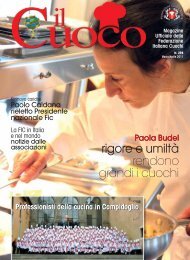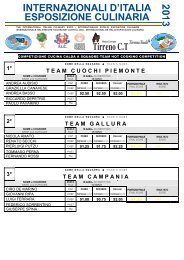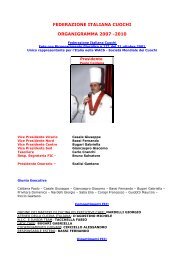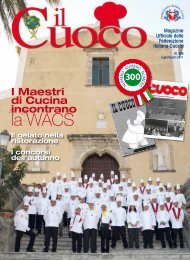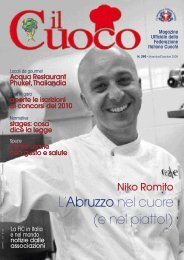N. 291 - Federazione Italiana Cuochi
N. 291 - Federazione Italiana Cuochi
N. 291 - Federazione Italiana Cuochi
Create successful ePaper yourself
Turn your PDF publications into a flip-book with our unique Google optimized e-Paper software.
can dip the tips into vinaigrette.<br />
The varieties of wild asparagus (or luparo)<br />
are enjoyed in the kitchen for their<br />
penetrating and slightly bitter taste.<br />
They are particularly suited to being eaten<br />
with foods which tend to be sweet<br />
such as rice and eggs.<br />
TINNED OR FROZEN?<br />
Tinned asparagus can be found on the<br />
market in various sizes, whole or in<br />
pieces or only the tips. Perhaps some<br />
people may find these handy out of season,<br />
but what is the point? The worst<br />
come from China and the unmistakeable<br />
smell (which for me is an intolerable<br />
“stink”) is due to the massive doses of<br />
glutamate, salt, ascorbic acid and other<br />
additives which we haven’t missed for<br />
thousands of years. If you really can’t<br />
avoid it, at least take the trouble to wash<br />
them in cold running water. But even if<br />
you do that you can’t help but notice<br />
their watery mediocrity. Some Spanish<br />
or Chilean brands of the white-giant type<br />
are just pickled and stand out for their<br />
texture which is slightly finer than their<br />
Chinese relatives. These (and only these)<br />
can find a mediocre justification in<br />
risottos, f lans or pies, after being<br />
blanched in unsalted boiling water.<br />
Frozen asparagus are much better: modern<br />
freezing technique do not kill their<br />
organoleptic or nutritional qualities. It<br />
is a pity that these are often low-priced,<br />
poor quality asparagus.<br />
In short, if you love quality and taste,<br />
you are better off not using surrogates<br />
and fakes. Spring will be here again next<br />
year too.<br />
F<br />
SEE PAGE 22<br />
FOR THE ITALIAN TEXT<br />
Smoke signals<br />
by Stefano Pepe<br />
Member and Secretary<br />
of the Team Veneto<br />
There are some people who still use natural<br />
wood chippings and others (the majority)<br />
who prefer the new faster and economic<br />
industrial techniques. Here is a description<br />
of the process to smoke fish, salami<br />
and cheeses<br />
A great variety of smoked foods can be<br />
found on the shelves of supermarkets, e-<br />
specially during the winter, ranging from<br />
salmon to Speck and cheeses, a tangible<br />
sign that they satisfy the taste and that<br />
people, in spite of the recession, are still<br />
buying products which are costly and of<br />
quality. But, are they really?<br />
The techniques used today to smoke<br />
fish, meat and other things are fast and e-<br />
conomical. They have nothing to do with<br />
the method used to produce the salmon<br />
or sword fish hung and surrounded by the<br />
smoke of natural woods….. Today, producers<br />
use the new industrial techniques<br />
and in addition to traditional smoking (being<br />
used less and less) they use “liquid<br />
smoke”, a condensed smoke based on water<br />
and other substances which, when it<br />
comes into contact with the product,<br />
catalyses giving it “the smell” and therefore<br />
the characteristic smoked appearance.<br />
The fish is sprayed or dipped in the<br />
“smoke” as are Prague hams, certain<br />
salamis, cheeses and other preparations.<br />
Speck, it seems, is an exception, not due<br />
to an industrial choice but to the conviction<br />
and attachment to traditions of cer-<br />
tain producer consortia of Alto Adige (long<br />
may they continue to live!!).<br />
Another discovery of research is electrostatic<br />
smoking: this is carried out with<br />
liquid smoke particles, charged with static<br />
electricity, which “stick” to the food. The<br />
latest invention is the smoking bag, which,<br />
with its wrapping of tinfoil treated with<br />
the substances mentioned above, transmits<br />
the characteristic smell of smoking with<br />
quality woods.<br />
Traditional smoking consists in exposing<br />
the foods to smoke generated by the<br />
combustion of woods and aromatic plants<br />
(fruit trees and bay, rosemary and others)<br />
improving their anti-microbic resistance<br />
and giving them the characteristic taste.<br />
Very little remains of the smoking<br />
process used years ago. These systems are<br />
certainly much more healthy than the classic<br />
one (they do not contain smoke molecules<br />
which are harmful for the health<br />
such as benzopyrene), we have to say this<br />
if we are to be honest, but their usage is n-<br />
ever declared on the label.<br />
So, the consumer has no way of knowing<br />
which technique has been used to produce<br />
the product he is eating and if the<br />
high sale cost is justified by the type of<br />
process used. The truth is that of all the<br />
chemical and natural aromatizers made by<br />
the producer industries, the aroma used<br />
the most is the “smoked” one.<br />
In the banqueting and catering company<br />
of Camposampiero (PD), where I am<br />
the head of production, we produce and<br />
serve salmon, tuna, sword fish, trout,<br />
game, loin of pork, aromatised lard, bacon,<br />
loin of beef and other things, all rigorously<br />
smoked according to tradition,<br />
with chips of quality woods from Alto<br />
Adige, with an old oven skilfully modified<br />
for use and, above all, with a pinch of passion<br />
and romanticism which in the<br />
“good, true restaurant tradition” never<br />
does any harm!<br />
Vuoi collaborare con la rivista IL CUOCO?<br />
Inviaci il materiale da pubblicare sulla nostra rivista!<br />
Sei specializzato in:<br />
• Sculture Vegetali<br />
• Lavorazioni del Cioccolato o Zucchero<br />
• Composizioni da Buffet<br />
• Pasticceria • Sculture in ghiaccio o altro<br />
Invia in redazione il tuo menu a tema o le tue proposte gastronomiche.<br />
Se il materiale sarà adatto, lo pubblicheremo volentieri!<br />
ERRATA CORRIGE<br />
nel n. 290 abbiamo pubblicato a pag. 53<br />
il nome errato della Lady Chef Marzia<br />
Garbinelli che ha realizzato la ricetta<br />
dei bucatini Rummo Lenta Lavorazione<br />
alla Breganzese.<br />
Ci scusiamo con l’interessata e i lettori.<br />
|79




